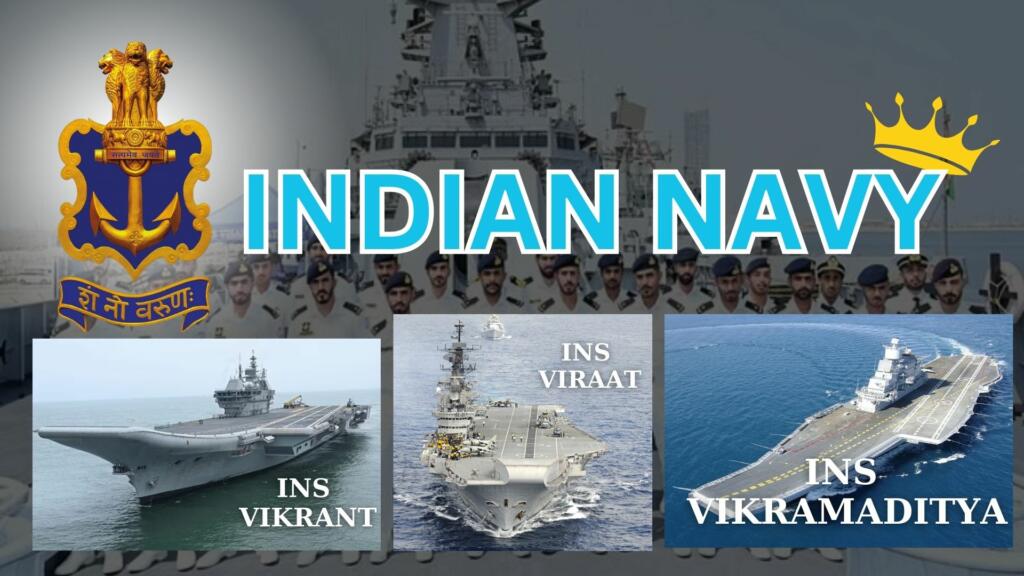Embarking on a historical odyssey, India’s naval legacy unfurls through the epic voyage of its titans – INS Vikrant, INS Viraat, and INS Vikramaditya. From the birth of maritime prowess with Vikrant’s inaugural sail to the dawn of indigenous naval supremacy with INS Vikrant’s commissioning in 2022, India’s narrative is one of resilience, innovation, and strategic foresight. This journey, etched in the annals of naval history, heralds India’s ascent as a formidable force on the global maritime stage.
The Birth of a Legacy-INS Vikrant
The saga of Indian aircraft carriers began with INS Vikrant, originally launched as HMS Hercules in 1945. Commissioned in 1961, Vikrant played a pivotal role in the 1971 Bangladesh Liberation War, defying doubts about its seaworthiness. Its swift and effective operations underscored India’s naval prowess and contributed significantly to the birth of Bangladesh. Despite undergoing major overhauls, Vikrant was decommissioned in 1997, ending a glorious chapter in Indian naval history.
Vikrant’s inception marked a significant shift in India’s naval strategy. The acquisition of the carrier from Britain in 1957 signified India’s recognition of the importance of maritime power projection. As the flagship of the Indian Navy, Vikrant symbolized the nation’s emergence as a formidable naval force in the region.
The 1971 Bangladesh Liberation War stands as a testament to Vikrant’s capabilities. Despite initial skepticism, the carrier proved its mettle by facilitating over 300 strike sorties in just 10 days. Its strategic significance in preventing reinforcement of Pakistani forces from the sea was instrumental in the creation of Bangladesh.
However, after years of service, Vikrant faced inevitable decommissioning due to maintenance challenges and rising costs. Despite its retirement from active duty, Vikrant continued to serve as a museum, attracting thousands of visitors keen on exploring India’s maritime heritage.
The Grand Old Lady-INS Viraat
Another iconic figure in India’s naval narrative was INS Viraat, formerly HMS Hermes. Commissioned into the Indian Navy in 1987, Viraat epitomized resilience and strength. From participating in Operation Jupiter to blockading Pakistani ports during Operation Vijay, Viraat played diverse roles in safeguarding India’s interests. However, in 2017, after years of distinguished service, Viraat bid farewell, symbolizing the end of an era in Indian maritime heritage.
Viraat’s legacy extends beyond its operational capabilities. As the oldest serving aircraft carrier in the world until its decommissioning, Viraat represented a link to India’s colonial past while embodying its aspirations for self-reliance in defense manufacturing.
The decommissioning of Viraat sparked discussions about preserving its historic significance. Despite efforts by state governments and crowdfunding initiatives, the decision was made to auction the ship for scrap, underscoring the challenges of preserving naval heritage in a rapidly evolving strategic landscape.
The Russian Connection-INS Vikramaditya
In 2013, India welcomed INS Vikramaditya, a refurbished Admiral Gorshkov from Russia. This acquisition marked a significant leap in India’s naval capabilities. With a displacement of 45,000 tonnes and the capacity to carry over 30 aircraft, Vikramaditya bolstered India’s presence in the Indian Ocean Region. Notably, it also became the first warship to house an ATM on board, showcasing advancements in onboard facilities. However, its journey was not without challenges, as evidenced by an unfortunate accident during a refit in 2016.
Vikramaditya’s entry into the Indian Navy signaled a strategic partnership between India and Russia in defense procurement. The negotiations and eventual acquisition of the carrier underscored India’s efforts to diversify its sources of military hardware and technology.
Despite challenges, Vikramaditya’s operational capabilities have enhanced India’s maritime security posture. Its participation in joint exercises with international partners, including the US Navy and the French Navy, highlights India’s commitment to cooperative security initiatives in the Indo-Pacific region.
A New Horizon-INS Vikrant
The culmination of India’s aspirations for indigenous aircraft carriers came to fruition with the commissioning of INS Vikrant in 2022. Built at a cost of Rs 19,500 crore, Vikrant stands as a testament to India’s technological prowess and self-reliance. With a length of 262 meters and a displacement of over 40,000 tonnes, Vikrant boasts impressive capabilities. Equipped with advanced weaponry and capable of operating various aircraft, including indigenous models, Vikrant represents a significant leap forward in India’s naval capabilities.
Vikrant’s commissioning heralds a new era in India’s defense manufacturing capabilities. Its successful construction and integration of advanced systems demonstrate India’s ability to design and build complex naval platforms indigenously. Moreover, Vikrant’s potential to operate a diverse range of aircraft underscores India’s ambitions to enhance its maritime power projection capabilities in the Indo-Pacific region.
Future Endeavors
With the success of INS Vikrant, India’s naval ambitions soar higher. Chief of Naval Staff Admiral R Hari Kumar’s announcement of a potential repeat order for an Indigenous Aircraft Carrier reflects the nation’s commitment to further strengthening its naval fleet. As India continues to assert its maritime presence in the Indo-Pacific region, investments in indigenous defense manufacturing and technological advancements will play a crucial role in shaping the future of its naval capabilities.
India’s strategic imperatives in the Indo-Pacific region necessitate a robust naval presence. The development and deployment of indigenous aircraft carriers serve as force multipliers, enhancing India’s ability to safeguard its maritime interests and contribute to regional stability. As the nation charts its course towards future endeavors, the legacy of its aircraft carriers will continue to inspire generations and secure India’s position on the global maritime stage.
Concluding the Pilgrimage of Triumph
India’s journey in the realm of aircraft carriers is a saga of triumph over challenges and a testament to the nation’s commitment to self-reliance and naval prowess. From the inception of INS Vikrant to the recent commissioning of INS Vikrant, each milestone underscores India’s evolution as a maritime power. As the nation charts its course towards future endeavors, the legacy of its aircraft carriers will continue to inspire generations and secure India’s position on the global maritime stage.
Also Read: Chenab Bridge: A Towering Marvel Surpassing Paris’ Iconic Landmark
